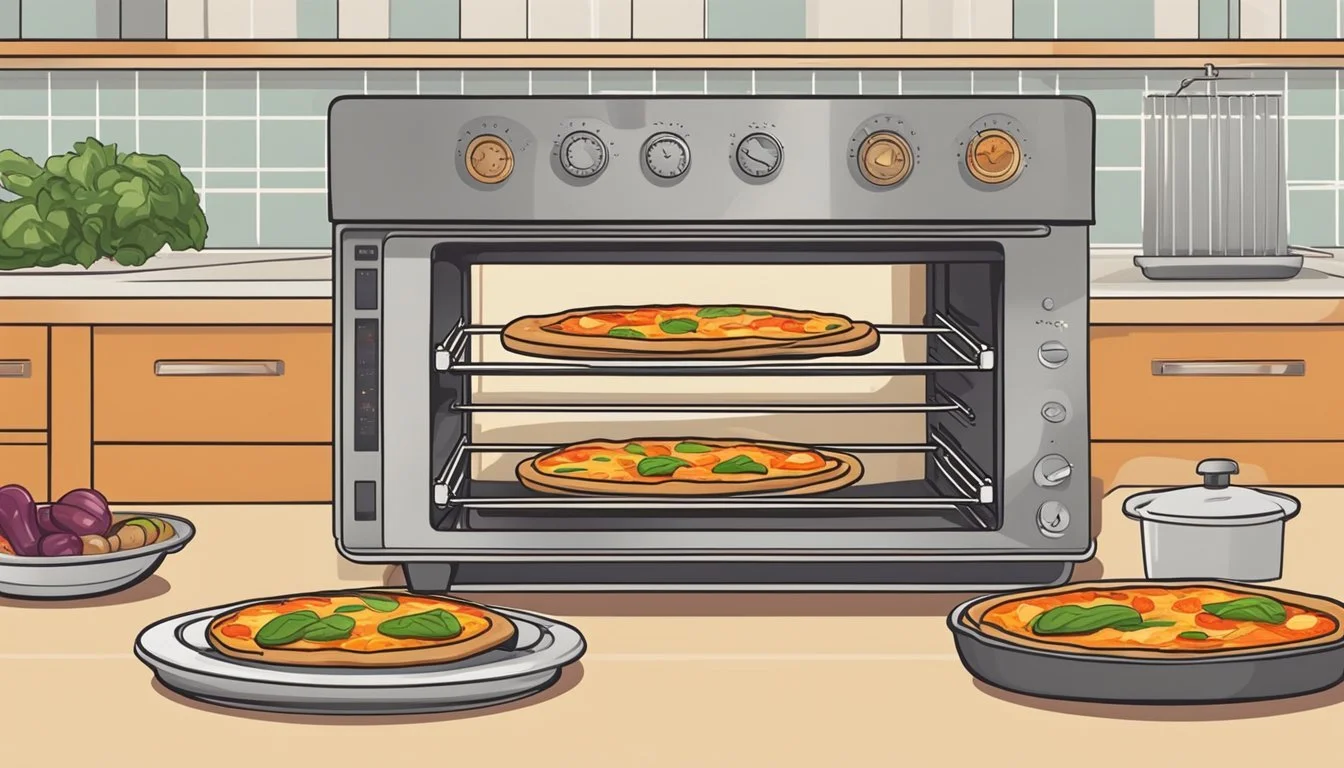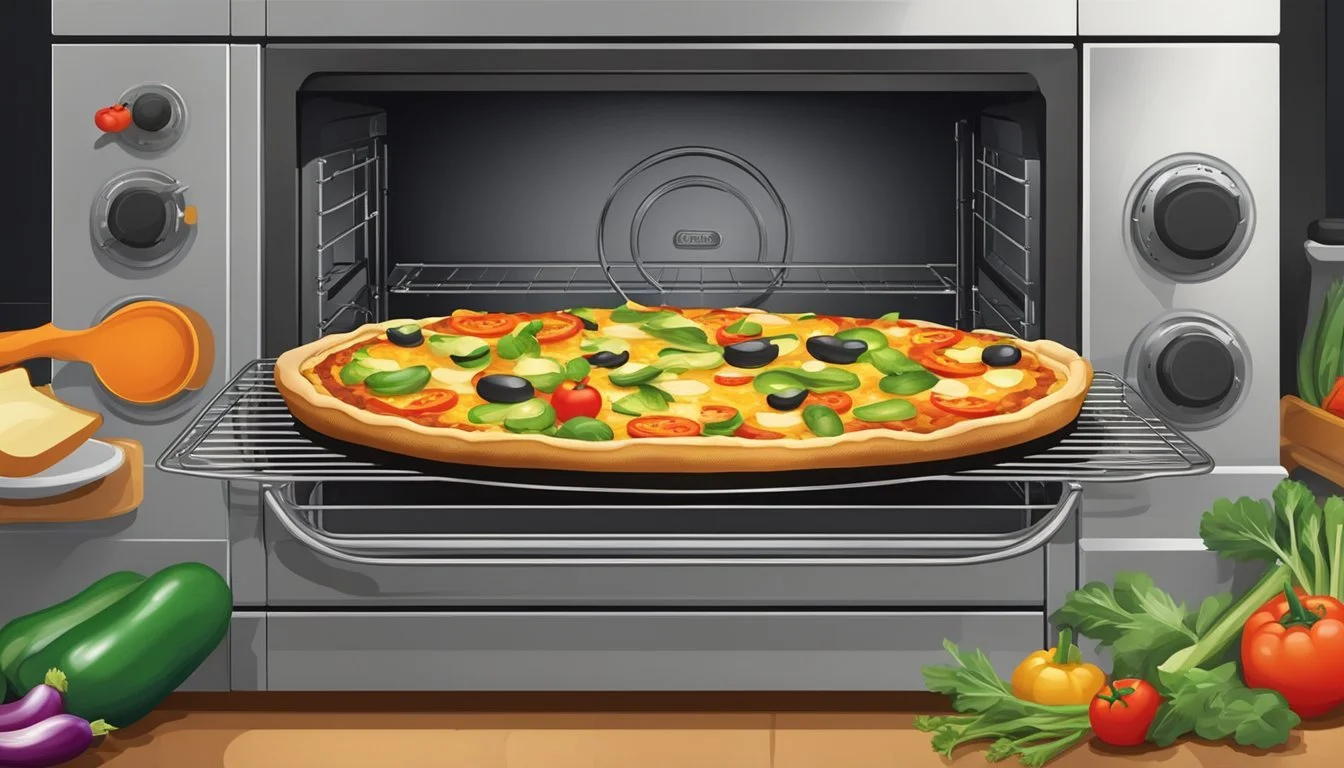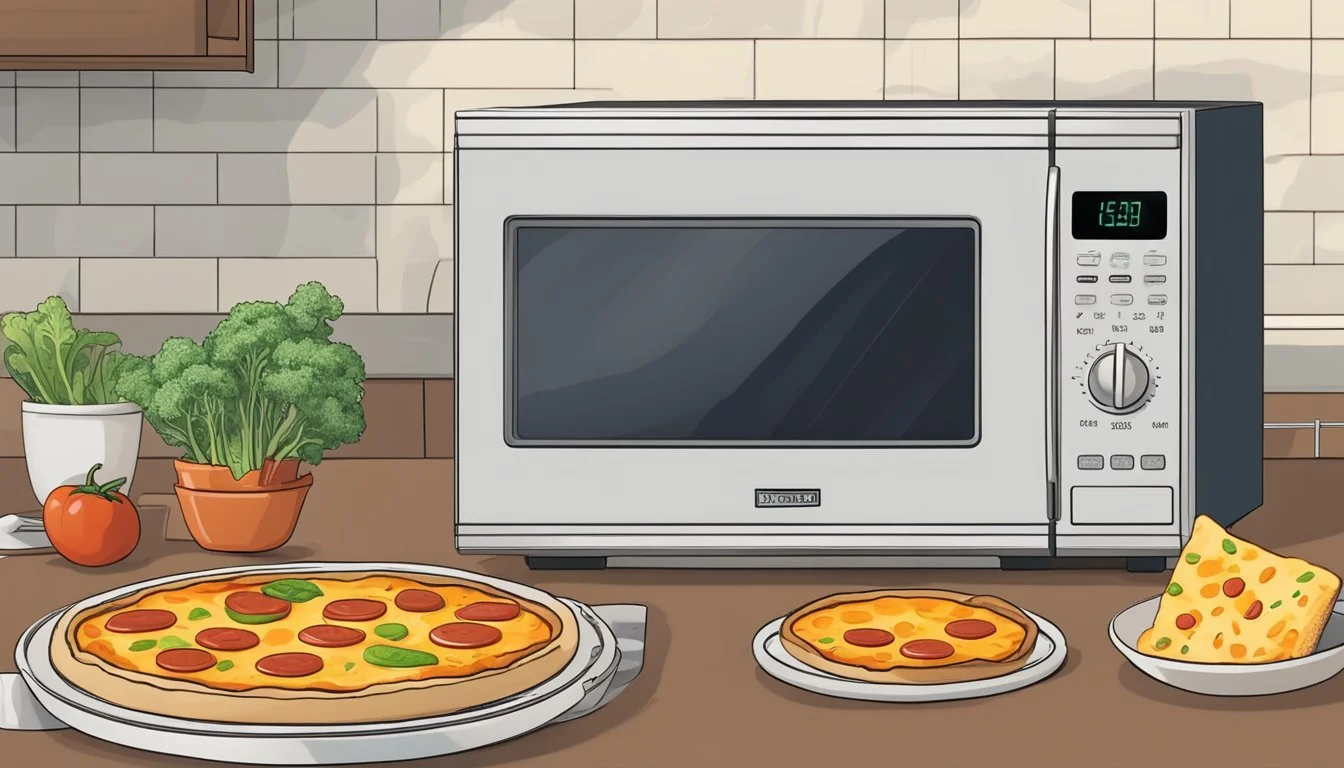How to Reheat Deep Dish Veggie Pizza to Maintain Crispiness
Reheating deep dish veggie pizza can be tricky if you want to maintain its delicious flavors and perfect texture. Whether you prefer using an oven, an air fryer, or a skillet, ensuring the pizza heats evenly is key to avoiding a soggy or burned crust. One of the best methods is to heat a nonstick or cast-iron skillet over medium heat, place the pizza slice in, and steam it slightly by adding a few drops of water and covering it with a lid.
For those with an air fryer, preheating it to 325°F (163°C) and reheating the pizza for about 6-7 minutes will get the job done efficiently. This method helps keep the crust crisp while bringing out the full flavor of the veggie toppings. Ovens can also be a great option; preheating to 350°F and using a parchment- or foil-lined baking sheet helps prevent burning.
By knowing these methods, anyone can enjoy leftover deep dish veggie pizza as if it were freshly baked. It's all about choosing the right reheating technique to preserve that perfect balance of crispy crust and savory toppings, ensuring every bite is as satisfying as the first.
Preparation for Reheating
Proper preparation ensures that your deep-dish veggie pizza reheats well, maintaining its
Choosing the Right Reheating Method
Reheating deep dish veggie pizza can be approached in several ways, each offering its own advantages depending on the available equipment and desired outcome. Here, we explore the pros and cons of using an oven, stovetop, microwave, and alternative methods like air fryers and toaster ovens.
Oven Method
The oven method is ideal for those wanting to maintain the crispiness of the crust while thoroughly heating the toppings. Preheat a conventional oven to 350°F (180°C). Place the pizza on a greased baking sheet or oven-safe dish to prevent sticking. For added moisture, place a small dish of water in the corner of the oven. Bake the pizza for 15-20 minutes or until it is heated through. The use of foil loosely covering the pizza can help prevent the cheese from burning.
Stovetop Method
Using a skillet on the stovetop is a quicker method and works well if you don't want to wait for the oven to preheat. Heat a nonstick or cast-iron skillet over medium heat. Place the pizza slice directly in the skillet and cook for about 2-3 minutes to warm the crust. Add a few drops of water to the skillet, away from the pizza, and then cover with a lid to create steam. This method keeps the crust crispy while ensuring the toppings are hot and moist without becoming soggy.
Microwave Method
The microwave method is the fastest, but can sometimes lead to a soggy crust. Place the pizza on a microwave-safe plate and cover it with a microwave-safe lid or another plate to retain moisture. Cook on medium power for 1-2 minutes, checking frequently to avoid overcooking. To improve texture, consider using a moisture boost method: place a cup of water in the microwave next to the pizza to prevent drying out.
Alternative Methods
Alternative methods provide flexibility for those without access to an oven or stovetop. A toaster oven works similarly to a conventional oven and is great for smaller portions. Preheat the toaster oven to 350°F and place the pizza on a lightly oiled tray. Bake for about 10 minutes or until hot. An air fryer is another effective option; set it to 350°F, and heat the pizza for 5-7 minutes. For those with access to a grill, preheat it and wrap the pizza in foil to prevent burning, heating for around 10 minutes. Each method offers a slightly different result, so choose based on your preferred texture and available tools.
Preparing to Reheat
Proper preparation ensures your deep-dish veggie pizza reheats evenly, maintaining a crisp crust and well-heated toppings.
Preheating Your Oven
Preheating the oven is crucial. For deep-dish veggie pizza, set the oven to 350 degrees Fahrenheit. This temperature is optimal for heating the pizza evenly without burning the crust.
Using a conventional oven is generally best, as it provides even heating. Make sure to give the oven enough time to reach the desired temperature before placing the pizza inside.
If you prefer an alternative, a toaster oven can work, but adjust the time accordingly. Always use the middle rack for even heat distribution.
Preparing the Pizza
Start by preparing a baking tray. Line it with parchment paper or aluminum foil to prevent sticking. Lightly spray the lined tray with cooking spray or a bit of olive oil for an added layer of non-stick assurance.
Carefully place the deep-dish slices on the tray. Ensure there is some space between slices to allow hot air to circulate effectively. If the pizza looks dry, lightly spray the slices with a small amount of water.
Covering the pizza loosely with another sheet of aluminum foil can help retain moisture. This way, the toppings heat up without the crust becoming soggy.
Reheating Deep Dish Veggie Pizza
Reheating a deep dish veggie pizza can be done effectively using an oven or on the stovetop. Each method has its own steps to maintain the crispy crust and ensure the toppings are warmed without becoming soggy.
In the Oven
Preheat the oven to 350 degrees Fahrenheit to avoid burning the already-cooked crust. Place the pizza slices on an aluminum foil-lined baking sheet. If the crust tends to dry out, lightly spray the slices with water or cover them loosely with another piece of foil to retain moisture.
Bake the slices for approximately 10-15 minutes, checking occasionally to ensure the pizza does not overheat. Halfway through, lift the top foil to allow the cheese to fully melt while preventing it from becoming too bubbly. This method helps achieve a crispy crust and evenly melted cheese.
On the Stovetop
Heat a nonstick or cast-iron skillet over medium heat. Place the pizza slice in the pan, ensuring it does not overlap. Cook for about 2 minutes to allow the crust to crisp up without adding any oil.
Add a few drops of water away from the pizza slice, and cover the skillet with a lid. This steaming process helps melt the cheese and heat the toppings without softening the crust. Use a spatula to transfer the slice to a plate once it's heated thoroughly, ensuring it retains both texture and flavor.
Post-Reheat Finishing Touches
Once your deep-dish veggie pizza is reheated, a few finishing touches can elevate its taste and texture. These steps ensure the toppings are flavorful, and the crust is perfect.
Checking for Doneness
To ensure your pizza is properly reheated, check the crust and toppings. The crust should be crispy and slightly golden. If the crust is still soft, it might need a few more minutes in the heat.
Inspect the toppings for bubbling cheese, indicating it is hot and ready to eat. Use a thermometer to verify the pizza has reached an internal temperature of at least 165°F (74°C). This ensures food safety and optimal taste.
Enhancing Flavor and Texture
To enhance the flavor, drizzle a bit of olive oil over the reheated slices. This adds richness and can improve the overall taste. For an added crispy touch, consider lightly toasting the crust by placing the pizza under the broiler for a minute or two.
Sprinkle some fresh herbs like basil or oregano over the hot pizza to brighten the flavors. Adding a pinch of sea salt can bring out the toppings' natural flavors, giving every bite a little more punch.
These small adjustments make a big difference in the final texture and flavor profile of your reheated deep-dish veggie pizza.
Troubleshooting Common Reheating Challenges
To ensure your deep dish veggie pizza reheats evenly, maintaining the right texture and flavor, focus on avoiding sogginess, preventing the tops from drying out, and ensuring a crispy crust.
Avoiding Soggy Pizza
One common issue when reheating pizza is ending up with a soggy crust. To prevent this, avoid using the microwave as it traps steam, which causes sogginess. Instead, reheat the pizza in the oven or a skillet.
For the oven method, preheat to 350°F and use a parchment-lined baking sheet. This setup allows the crust to crisp up while preventing moisture build-up.
In a skillet, heating the pizza over medium heat helps maintain a dry environment. Add a few drops of water to the skillet away from the pizza, then cover with a lid to steam the toppings without making the crust soggy.
Preventing Dried-Out Tops
Drying out of toppings is another challenge. This can be managed effectively by controlling the moisture during reheating. For oven reheating, lightly spray the pizza with water before covering loosely with foil. This helps lock in moisture and avoids drying out the top.
If using a skillet, place the pizza slice without adding oil. Heat over medium for a couple of minutes, then add a few drops of water. Covering the skillet with a lid briefly steams the pizza, keeping the toppings moist without compromising the crust.
These methods ensure toppings like vegetables retain their juiciness and don't become over-dried.
Ensuring a Crispy Crust
Achieving a crispy crust is essential for deep dish pizza. Using a microwave often results in a less crisp texture. Ovens and skillets are preferred for this reason.
In the oven, bake at 350°F to 450°F depending on thickness. This lower-to-high temperature balance crisps the crust without burning. Use a piece of foil loosely to prevent the crust from hardening too much while ensuring it crisps up well.
For skillets, turn to medium-high heat. This allows the bottom of the crust to achieve a good crispy texture. No additional oil is needed, just make sure to monitor closely to avoid burning. This results in a perfectly crispy crust that complements the toppings.
Alternative Reheating Techniques
Alternative methods can offer unique flavors and textures to your reheated deep dish veggie pizza. By using a grill or pan-frying, you can achieve a smoky flavor or a crispy crust respectively, which might be more appealing than conventional reheating.
Using a Grill
Reheating deep dish veggie pizza on a grill can impart a nice smoky flavor. Preheat the grill to medium-high heat. Place the pizza slices directly on the grates or use a griddle for better stability. Close the lid to maintain heat.
Check frequently to avoid burning, as grills can be unpredictable. The cheese should melt while the crust becomes crispy. This method is perfect for outdoor gatherings or when you want to add a touch of BBQ essence to your pizza. Make sure to flip the pizza carefully if using a griddle to ensure even heating.
Pan-Frying for Crispiness
To achieve a crispy crust, pan-frying is an excellent alternative. Use a cast-iron pan for best results. Heat a small amount of oil over medium heat and place the pizza slices in the pan. Cover the pan with a lid to help melt the cheese evenly.
Monitor the pizza closely to prevent burning. The cheese should be gooey, and the bottom crust should be golden brown. This method ensures a crispy texture that many pizza lovers enjoy. Adjust the heat as needed to avoid scorching the crust. Pan-frying offers a quick and efficient way to reheat pizza while enhancing its flavor and texture.
Serving and Enjoying Your Pizza
Reheating deep dish veggie pizza is just the beginning. Proper serving techniques and thoughtful side pairings enhance the taste and texture of your meal, allowing you to fully enjoy every slice.
Cutting and Serving
Use a sharp knife or pizza cutter to ensure clean slices of your deep dish veggie pizza. A spatula helps lift each slice without losing any toppings.
Cut the pizza into even slices to provide a consistent eating experience. Serving the pizza hot is crucial; the cheese should be melted and the crust slightly crispy. Deep dish pizza retains heat well, but serving immediately after reheating preserves its fresh taste and texture.
Pairing with Sides
Pair your pizza with sides that complement its rich flavors. A fresh salad with crisp lettuce, tomatoes, and cucumbers adds balance. Consider a light vinaigrette dressing to avoid overpowering the pizza's flavors.
Garlic bread or bruschetta can accompany the pizza, offering extra texture and taste. For beverage options, sparkling water or a light soda cleanses the palate, while a glass of red wine, like Chianti, pairs wonderfully with veggie toppings. This balance of flavors and textures enhances the overall meal experience.
Conclusion
Reheating deep-dish veggie pizza is a crucial step to maintaining its flavor and texture.
Using an oven to reheat Chicago-style pizza is often recommended for best results. Preheat at 350°F and use a foil-lined baking sheet. This method evenly heats the pizza without burning the crust.
For those in a hurry, an air fryer can be effective. Set it to 325°F and heat for 6-7 minutes. This approach ensures the pizza warms evenly, preserving its original taste and texture.
Another reliable method is the skillet. Heat a nonstick or cast-iron pan over medium heat. Place the pizza slice in the skillet for 2 minutes. Add a few drops of water away from the pizza and cover. This steams the toppings without making the crust soggy.
Regardless of the method, reheating leftover pizza properly can bring back its delicious taste, making it almost as good as freshly baked.









